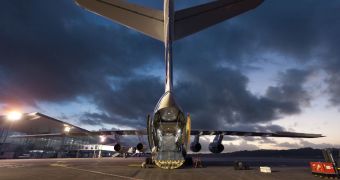On Friday, August 17, the fourth Galileo In-Orbit Validation (IOV) satellite arrived at the Cayenne Airport, in French Guiana, South America, aboard a Russian-built Ilyushin aircraft. The vehicle is scheduled to join the third IOV in the same rocket, scheduled to launch this autumn.
The satellite has since been transported to the European Space Agency's (ESA) Kourou Spaceport, which is where the organization launches all of its rockets from. The Galileo satellite navigation and positioning system is also based here.
The IOV is the first phase of assembling Galileo, which is Europe's response to the American-built Global Positioning System (GPS). China and the Russian Federation are also building their own navigation systems, called Beidou and GLONASS, respectively.
ESA launched the first two IOV satellites on October 21, 2011, aboard a Soyuz rocket provided under an agreement with the Russian Federal Space Agency (RosCosmos). Europe plans to use Soyuz delivery systems for all 22 IOV satellites, and maybe even beyond.
In all, Galileo will feature 30 spacecraft, of which 3 will be spares. They will move around Earth in an intermediate circular orbit (MEO), at an altitude of 23,222 kilometers (14.430 miles), higher than American GPS satellites.
According to ESA officials, the Galileo satellites will be launched in pairs. The next one, featuring the third and fourth spacecraft, is due to take off later this year, in October. The vehicles are known as David and Sif, respectively (formerly, FM3 and FM4).
Both were delivered to Cayenne Airport from a facility manufacturer Thales Alenia Space operates in Rome, Italy. FM3 was delivered to South America just 10 days earlier, on August 7, ESA says.
The launch “will mark a significant step in Europe’s program because it will complete the deployment of infrastructure required for the IOV phase and will allow for the first time a computation of on-ground position based solely on Galileo satellites,” officials from the agency explain.
“The IOV phase is being followed by the deployment of additional satellites and ground segment as required to achieve the ‘Full Operational Capability’, leading to provision of services,” they go on to say.

 14 DAY TRIAL //
14 DAY TRIAL //